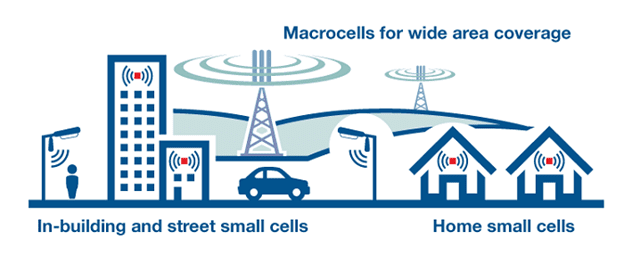To use wireless communication devices, we need cell towers around us. There are different broadband cellular network technologies, for example, 4G. In this article, you can read all you need to know regarding 4G towers, their coverage, and, most importantly, how to locate one successfully.
We will take a deeper look into the features of the 4G tower and what makes it different from other cell towers. So, what does a 4G tower look like? If this is the information you want, keep reading this article until the end.

What Does a 4G Tower Look Like?
As you probably already know, the cell tower remains an essential part of the mobile network. Regardless of which network and frequency we are talking about, 3G, 4G, or 5G, they all require cell towers to cover as much area as possible.
However, with the increased use of the 5G network, the number of 4G and 5G towers became almost equal. So, what does a 4G tower look like?
The term macrocell is the simplest way to describe the 4G tower. Because 4G technology needs longer coverage, the 4G network uses macrocells which provide low-frequency coverage.
Moreover, compared to other types of network coverage equipment, the macrocells are the most expensive to install.
Additionally, as the macrocells are pretty complicated and detailed, you can read much more in-depth information about them in the continuation of this article.

Features of the 4G Tower
After reading what kind of cell tower the 4G network uses, you can now see which features make macrocells different from other coverage equipment.
We will look at the top four most significant differences, the coverage radius, building penetration, cost, and installation.
The coverage radius
The coverage radius is the first and foremost difference between macrocells and small-cell technology.
As 4G technology is characterized by its low frequency, macrocells are explicitly designed to emit low-frequency coverage for long distances. Most of the time, these long distances reach miles.
Moreover, because these macrocells cover such long distances, the 4G signal usually gets all over the place, resulting in a poor connection, waste of energy, waste of power, and low effectiveness.
Building penetration
The second feature is the building penetration feature of the macrocells. Namely, this feature shows whether a particular connectivity from a cell tower will work indoors or not.
That said, regarding the macrocells and 4G technology, the building penetration is at the highest levels.
Thanks to the high coverage that macrocells emit, the lower frequencies from the 4G network can travel far and penetrate windows, walls, doors, and any other physical obstacles or barriers.
Cost
Regarding the cost of the macrocells, there is a huge difference between setting up a 44 macrocell tower and a 5G small cell tower. On average, one macrocell can cost about up to $200,000 to set up, while a small cell can cost under $10,000.
Another thing you need to know here is that 4G macrocells can be upgraded to emit 5G frequency, but this process is even costlier and might take many years to complete.
Installation
As you can already guess, installing the 4G macrocells requires much longer compared to small cells. Besides the longer installation process, macrocells need much more time to set up and start working.

Which Components Does a 4G Tower Have?
As much as it is important to know about the 4G tower, it is equally important to know which components it has.
Before we continue, I just want to disclose that as macrocells are highly complicated and have numerous components, in this article, we will be looking only at the most important ones.
Towers and poles
The first and most prominent component of the macrocell 4G towers are the towers and poles, which are characteristic because of their unusually large height.
Various additional components and equipment connected to these towers and poles are essential to the entire tower.
For instance, on the base of the tower, you can see some additional equipment such as trapeze kits, GPS antennas, BTS equipment platform, grounding kits, wires, etc.
Weatherproofing
Somewhere below the middle of the tower, there is weatherproofing equipment that protects the tower from different weather conditions, such as strong winds and rains, intensive snow, and extreme heat.
Tower lightning, ice shields, and microwave antennas
Besides other smaller components, you can notice the tower lightning, ice shields, and microwave antennas on the upper part of the macrocell tower.
All these components are placed nearby, making it easier for you to spot them and confirm that a cell tower is indeed a 4G tower.
Multi-band panel antennas
Ultimately, on the top of the 4G tower, you can notice the multi-band panel antennas that make these towers recognizable and one-in-a-kind. There are usually three of these multi-band panel antennas, and they are placed one next to another.
Other Important Information
Now let’s see some other specifics that make the 4G macrocells unique. First is the power; a typical macrocell can have around twenty to forty watts.
Regarding the height, 4G towers can vary from 49 feet (15 meters) up to 82 feet (25 meters), which is incredibly tall.
Finally, the 4G towers are usually located outside the residential areas and can be found in more rural places around the cities.
How to locate a 4G tower?
It is time to learn how to locate a 4G tower. Namely, the most efficient way to do this is by utilizing an application that locates cell towers near you. You can choose one of many applications of this type and simply search the area you are interested in on the map in the app. You can also check out cell tower company websites for this info.
Another method you can try is checking the website of your internet service provider, as they often include coverage maps and valuable information regarding this topic.
Conclusion
So, what does a 4G tower look like? I hope now you know everything about it and how you can locate one in your surrounding area.
Take care!
